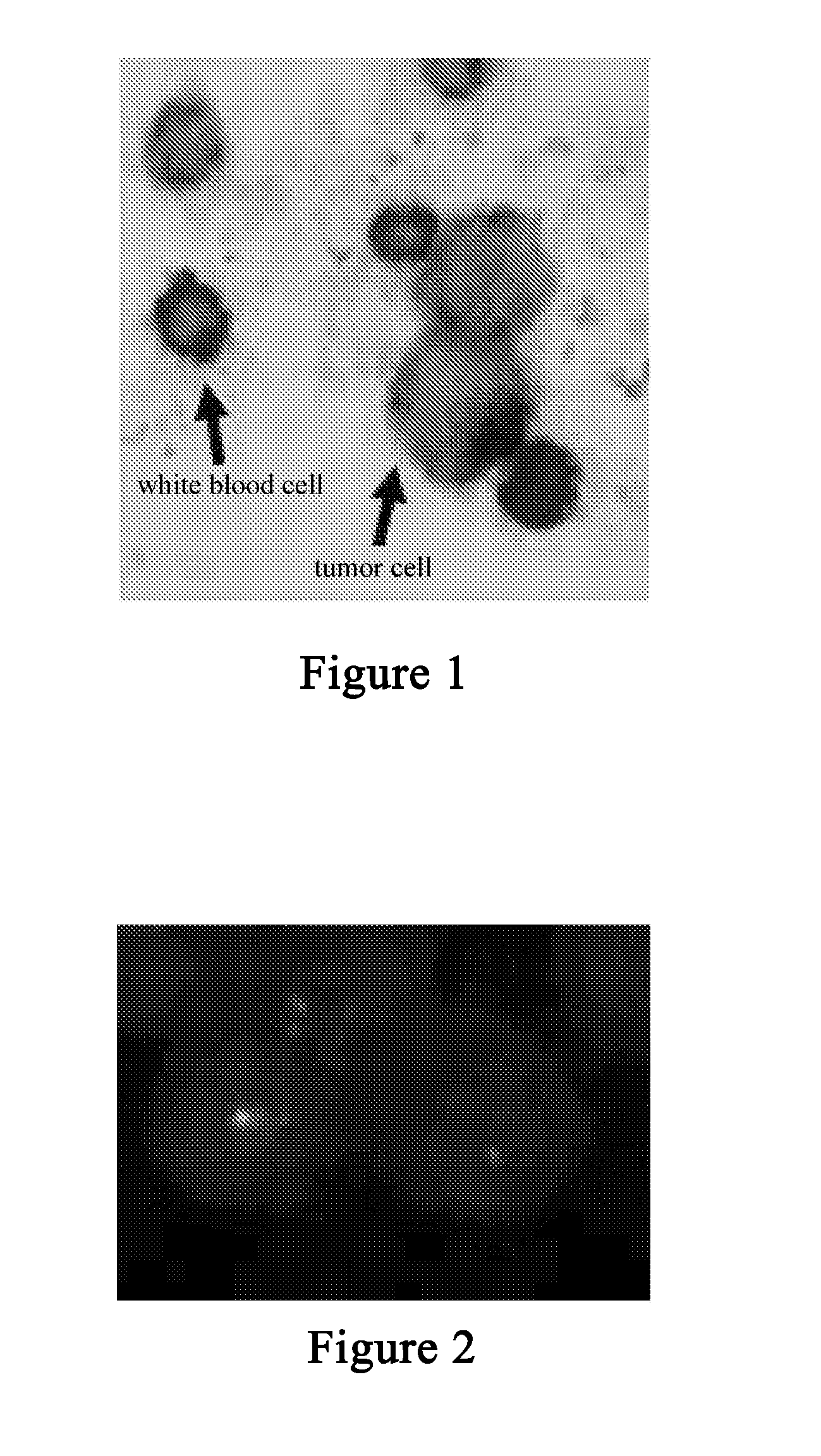Integrated Method for Enriching and Detecting Rare Cells from Biological Body Fluid Sample
a biological body fluid and enrichment method technology, applied in the field of integrated methods for enriching and detecting rare cells from biological body fluid samples, can solve the problems of difficult subsequent analysis and research thereto, unable to capture a lot of tumor cells, and proving time-consuming, and achieves good cell morphology and high recovery rate.
- Summary
- Abstract
- Description
- Claims
- Application Information
AI Technical Summary
Benefits of technology
Problems solved by technology
Method used
Image
Examples
example 1
Enriching the Circulating Tumor Cells in Peripheral Blood of a Breast Cancer Patient
[0063]5 ml of human peripheral blood is collected in a blood collection tube (BD, New Jersey, USA) containing ethylene diamine tetraacetic acid (EDTA) anticoagulant. The supernatant can be absorbed out with a pipette or automatic liquid-absorption device so as to remove plasma proteins after the blood samples are centrifuged (700×g, 10 minutes). The deposit obtained after centrifugation is resuspended in 30 ml of a red cell lysis solution (BD Pharmingen, California, USA) and incubated for 20 minutes. The specimen centrifugation is carried out (700×g, 10 minutes) so as to separate the lysed red blood cell chips in the supernatant. The deposit (i.e. deposited cells) is resuspended in 5 millilitre of phosphate buffer (pH 7.4) after the supernatant is removed. 0.5 millilitre of magnetic beads coated with a monoclonal antibody against white blood cell surface antigen such as CD45 (Invitrogen, California, ...
example 2
Tricolor Staining the Circulating Tumor Cells Enriched in Peripheral Blood of a Breast Cancer Patient
[0065]The enriched circulating tumor cells are put on the glass slide and fixed by 2% of paraformaldehyde prepared from phosphate buffer for 2 hours at room temperature, followed by washing thrice with phosphate buffer. The cells and a mixture (diluted by phosphate buffer) containing biotin (Pierce, Ill., USA) labelled monoclonal antibody (Abcam, UK, 1 μg / ml) against keratins 8+18+19 and rhodamine (Pierce, Ill., USA) labelled monoclonal antibody (Abcam, UK, 1 μg / ml) against CD45 are incubated for 30 minutes at a room temperature. After the glass slide is washed thrice with the phosphate buffer, it is incubated for 30 minutes at the room temperature with a mixture (diluted by phosphate buffer) containing alkaline phosphatase labelled monoclonal antibody (Sigma, Missouri, USA, 1 μg / ml) against biotin and peroxidase (Pierce, Ill., USA) labelled monoclonal antibody (Abcam, UK, 1 μg / ml) a...
example 3
Detecting the Circulating Tumor Cells by a Chromosomal Fluorescence in situ Hybridization
[0067]The enriched tumor cells are put on the glass slide as specimens. The glass is rinsed with SSC buffer after the stained specimens are treated with 20 milligramme / millilitre of RNA enzyme for 1 hour. The specimens are dehydrated with absolute ethyl alcohol for 10 minutes and then heated to 70° C., holding for 5 minutes for denaturation. The specimens are dehydrated with absolute ethyl alcohol for 10 minutes again, and hybridized and incubated with a probe at 45° C. overnight. The specimens are observed by a fluorescence microscope after being washed with the SSC buffer. The specimens can be the enriched tumor cells stained with the method in Example 2. The object of carrying out chromosomal fluorescence in situ hybridization is further confirming authenticity of detecting the tumor cells by tricolor staining based on immunohistochemistry. For the sake of rapid diagnosis, the specimens may n...
PUM
| Property | Measurement | Unit |
|---|---|---|
| diameter | aaaaa | aaaaa |
| diameter | aaaaa | aaaaa |
| pH | aaaaa | aaaaa |
Abstract
Description
Claims
Application Information
 Login to View More
Login to View More - R&D
- Intellectual Property
- Life Sciences
- Materials
- Tech Scout
- Unparalleled Data Quality
- Higher Quality Content
- 60% Fewer Hallucinations
Browse by: Latest US Patents, China's latest patents, Technical Efficacy Thesaurus, Application Domain, Technology Topic, Popular Technical Reports.
© 2025 PatSnap. All rights reserved.Legal|Privacy policy|Modern Slavery Act Transparency Statement|Sitemap|About US| Contact US: help@patsnap.com

